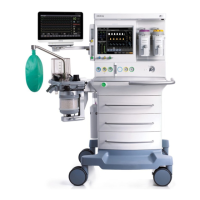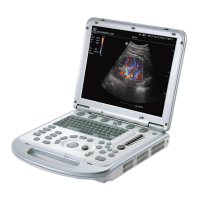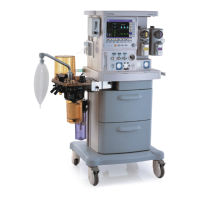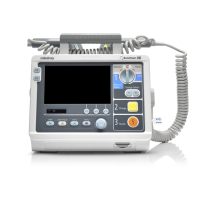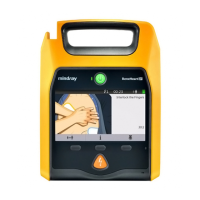A-3
A.1.3 Description
This product is pneumatically driven, microprocessor controlled ventilator. As the
integration of electronics, pneumatics, mechanics, software and other subjects, the ventilator
can partially or fully replace the ventilation function of the patient. During the inspiratory
phase, the inspiration valve opens. High pressure Air and O2 supplies enter the ventilator,
pass through an Air and O2 mixer, and become fresh gas with specific concentration of O2,
and specific flow or pressure. The fresh gas enters the patient’s lungs through hose. During
the expiratory phase, the inspiration valve is closed while the expiration valve opens. The
gas is expired by the patient’s efforts.
The O2 and Air supply connectors are designed as required by the relevant standard to
prevent from wrong connection. Filter (F1/F2) filters the water, oil, and other foreign
substance in the supplied gas. Pressure switch (PS1/PS2) monitors the pressure of supply
gas and gives an alarm in case of low supply gas pressure. Check valve (CV1/CV2) ensures
unidirectional gas flow. Regulator (REG1/REG2) reduces and stabilizes the pressure of
supply gas to ensure that the inspiratory proportional valve at the rear end outputs stable and
repeatable flow.
Proportional solenoid valve PSOL1/ PSOL2() is controlled by drive current. Different drive
currents correspond to different flows of solenoid valve so as to achieve accurate control of
inspiratory flow. Dust filter (F3/F4) is placed before flow sensor to stabilize gas flow,
facilitating measurement by sensor. Flow sensor (Q1/Q2) is hot-wire flow sensor for
accurate measurement of gas passing through and does not require calibration.
After flowing through the flow control subsystem, O2 and Air are mixed in the gas mixing
system. Make sure that O2 and Air are evenly mixed before flowing through O2 sensor
(OS). Otherwise, the measured value by the O2 sensor is not consistent with the actual O2
concentration. Inspiratory safety valve (SV) is controlled by electromagnet. When the
ventilator works normally, the electromagnet is powered on and the safety valve is closed.
When the pressure in the inspiratory path exceeds the preset pressure, the electromagnet is
powered off, the safety valve opens, and the gas is released through pressure relief valve
(RV1). When the system is powered off, all electronically controlled components inside the
ventilator cannot work. In this case, the electromagnet is in power-off status and the safety
valve opens. The patient inspires the ambient air through the spontaneously inspiratory path.
Check valve (CV3) ensures the unidirectional gas flow and prevents repeated breathing
during the patient’s spontaneous inspiration. Inspiratory pressure sensor (PI) monitors the
pressure in the inspiratory path. Zeroing three-way valve (SOL1) zeroes the inspiratory
pressure sensor periodically. RV2 is mechanical pressure relief valve. It releases pressure
when the pressure exceeds 110±10cmH2O. RV2 opens to release pressure when the airway
pressure reaches the release pressure to ensure the patient safety.
